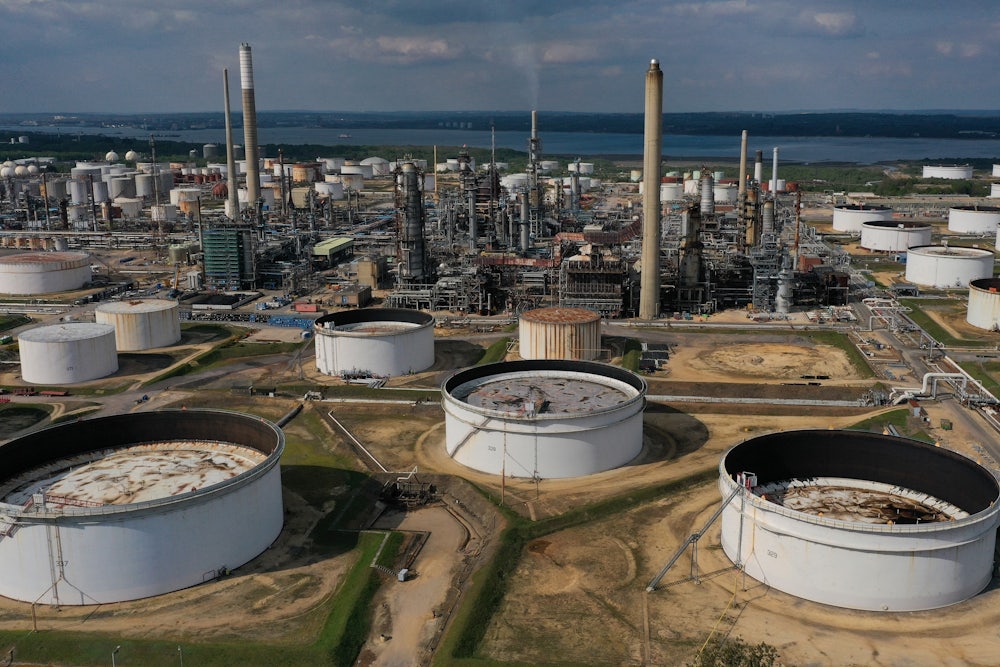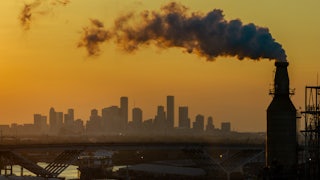ExxonMobil is betting that the world will use about as much oil in 2050 as it does now, or maybe even more. Despite a scorching summer and drumbeat of worrying stories about just how hot the planet is getting, climate hasn’t been a major topic of conversation in the U.S. election cycle. The United States is still ostensibly committed to doing its part to reduce emissions by 50 percent below 2030 levels by 2030—the pledge it made under the Paris climate agreement—but few experts expect that to happen.
Models from the Intergovernmental Panel on Climate Change, or IPCC, suggest that oil use would need to fall to 65 million barrels per day in 2050 in order to meet the Paris Agreement’s goal of limiting global temperature rise to “well below” 2 degrees Celsius (3.6 degrees Fahrenheit). Exxon, by contrast, predicts in their recently released annual forecast, called “Global Outlook,” that demand will still be above 100 million barrels per day by that time, slightly higher than it is now.
According to Exxon’s projections, nearly all of that demand will come from growing lower- and middle-income countries. That’s not a controversial point, exactly—across global energy models, growing fossil fuel demand is expected to come from emerging economies in the Global South. What’s unique about Exxon’s projection is that declines in gasoline demand due to the proliferation of electric passenger vehicles would be almost entirely offset by demand for oil from other places. The report states that demand for liquid fuels by “commercial transportation and feedstocks for the chemicals industry” (presumably including the Exxon-made plastics showing up in human brains, blood, and placentas) will fill the gas-guzzler-shaped hole in their balance sheet.
This isn’t just wishful thinking on Exxon’s part, and the company isn’t wrong to say that the world is not on track to get to net-zero by 2050. Despite the last few years of flashy pledges and initiatives, countries around the world, including the U.S., are mostly failing to enact the kinds of policies and regulations that would put the goals of the Paris Agreement within reach. Projecting current policies into the future could see the world warm by 2.5 degrees Celsius. Neither are wealthy countries making much effort to provide the kinds of financial support and debt relief necessary to make more sustainable, less fossil-fueled development possible for poorer parts of the planet.
ExxonMobil portrays itself in this report and elsewhere as a humble supplier of ever-growing demand. That’s a little disingenuous, of course. The company has cultivated a ballooning market for its products and worked to stymie efforts to reduce emissions at just about every level of government, pouring money into sophisticated lobbying efforts and the pockets of politicians who can be expected to vote against climate measures. More than 60 percent of the company’s donations to federal candidates this election cycle have flowed to Republicans.
Parts of Exxon’s recent report read like threats to those same politicians. Specifically, the report paints a terrifying picture of what could happen if there were “no new investment” in oil and gas. Global oil supplies would fall by 15 million barrels per day in the first year, the report states. By 2030, “oil supplies would fall from 100 million barrels per day to less than 30 million—that’s 70 million barrels short of what’s needed to meet demand every day,” according to Exxon’s projections. The results of that would be “dire,” creating severe energy shortages within a year of the imagined end of investment in oil and gas. The company warns that oil prices could quadruple in just one year, and that—within 10 years—unemployment rates would likely reach 30 percent, “higher than during the Great Depression of the 1930s.” Avoiding such a hellscape, Exxon warns, requires “sustained investment” so that companies like Exxon can continue to meet growing demand and “invest billions to lower the greenhouse gas emissions associated with its own operations and help other industries lower theirs.”
Given that there are no serious proposals on the table to end all investments in oil and gas production overnight, it’s hard to read Exxon’s theatrical projections here as anything other than needless fearmongering about so-called environmental, social, and governance, or ESG, investing. The image Exxon conjures here is of a conspiracy of woke investors suddenly deciding to withdraw their support from the industry on climate activists’ advice, letting oil fields run dry and sparking global economic chaos. There’s no evidence that this conspiracy—a favorite right-wing bogeyman—actually exists.
These theatrics, however, serve as a convenient distraction from the larger danger of what’s likely to happen if fossil fuels grow unchecked; if excess emissions continue, and the world has no capacity to suck enormous amounts of carbon out of the atmosphere; if plastics continue to accumulate in the environment, overwhelming our blood-brain barriers; if large parts of the planet become too hot to inhabit. It’s well within ExxonMobil’s mandate to tell a story of the future that suits its own bottom line. Governments ostensibly committed to keeping their constituents alive, healthy, and financially stable probably shouldn’t keep standing by as that story keeps coming true.








